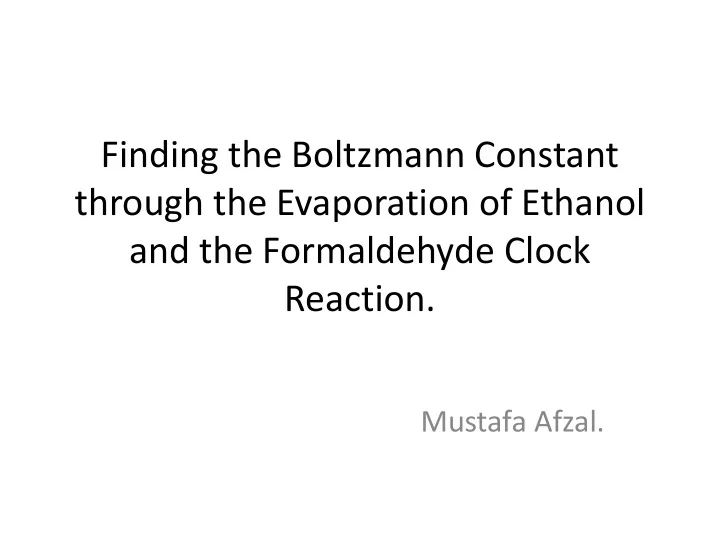

Finding the Boltzmann Constant through the Evaporation of Ethanol and the Formaldehyde Clock Reaction. Mustafa Afzal.
The Formaldehyde Clock Reaction – Theory. • Solution A 5 g of Anhydrous Sodium diSulfite + 1 g of Anhydrous Sodium Sulfite + 1 L of Distilled Water. • Solution B 10 cm cubed of 37% Formaldehyde Solution + 1 L of Distilled Water + (after 24 hours) 1 g of Phenolphthalein.
Theory – Continued. • Mix equal volumes of both solutions. • After some time, ‘delta T’, the solution turns pink.
The Equations and the Math. • The rate of the reaction is governed by the Arrhenius Equation.
The Equation and the Math. • u the reaction speed. • A a constant. • Ea energy of activation. • K the Boltzmann Constant. • T the temperature (in Kelvin) at which the reaction occurred.
The Equation and the Math – The Linear Form.
The Experimental Setup – Equipment • A hot plate. • Magnetic Stirrer to distribute heat uniformly. • A Temperature Probe. • Oil Bath. • Test Tubes. • Stop Watch. • Funnel.
The Experimental Setup – A Snapshot.
The Experiment. • 5 cm cubed of each solution was placed in separate test tubes. The test tubes were half immersed in the oil bath the temperature of which was monitored constantly. • After 5 minutes the two solutions were mixed and the stopwatch was started simultaneously.
The Experiment – Continued. • The stopwatch was stopped the instant the pink color appeared. • The experiment was repeated three times at the same temperature. • The entire procedure was repeated at 27, 40, 51 and 58 degrees Celsius.
Results • The value of the Activation Energy was taken from literature. • Ea = 9.30 x (10^22) J. • A graph of ln(1/time) against Ea/Temperature was plotted.
Results – The Graph. -2 data 2 linear • Add the Graph -2.5 -3 ln(1/time) -3.5 -4 -4.5 2.8 2.85 2.9 2.95 3 3.05 3.1 3.15 1/(Ea*T) -22 x 10
The Boltzmann Constant. Gradient = -6.7659 x (10)^22 (-1/k) = -6.7659 x (10)^22 k = 1.478 x (10)^ -23 J/K
Error. • The percentage error comes to about 9.8% when compared to the literature values. • Reasonable estimation of the Boltzmann Constant.
The Evaporation of Ethanol – Theory. • The 4 Assumptions: 1. The concentration of Ethanol outside the container is zero. 2. There exists no temperature gradient within the bulk of the liquid. 3. There exists a steady flow of air outside the container. 4. Above the surface of the Ethanol there exist saturated vapors of Ethanol.
Theory – Fick’s Diffusion Law.
Theory – Assumption # 1
Theory – Another Assumption.
Theory – Yet Another Assumption.
Fick’s Law after Assumption # 5, 6 & 7
After a Lot of Math.
Yet Another Assumption.
After some more Math.
C3
The Experimental Setup – A Snapshot.
The Experiment – Software Used. • Labview To check the temperature variations. It was determined that they were not significant. • Logger Pro Interfaces Lab Pro with the computer. Lab Pro gathered information from the… • Force Sensor (devise) Measured the weight of the alcohol after every 100 seconds.
The Disaster. • On the 12 th of June, the experiment was started. On the 6 th day, three consecutive power failures caused the data collected to crash. • A re-run was immediately started. • The experiment which was scheduled to finish on the 22 nd now finished on the 27 th .
The Results on the 27 th . Weight vs. Time 1.6 1.5 1.4 Weight / Newtons 1.3 1.2 1.1 1 0.9 0.8 0 1 2 3 4 5 6 7 8 9 10 Time / Days
Some Problems. • On Monday morning, 5 grams of the Ethanol were unaccounted for. • On Wednesday, 1 gram of Ethanol was unaccounted for. • Restricted to two parts of the graph and not the entire graph as a whole. • The evaporation procedure was not yet complete.
What to do now? 1. Evaluate the Boltzmann constant for the two separate parts. 2. Theoretically account for the mass loss.
Apologies. • I have not yet been able to calculate the Boltzmann constant through the evaporation of ethanol. However considering the nice trend of the graph and the good behavior of temperature I can be confident of a highly accurate answer.
Thank you !
Recommend
More recommend